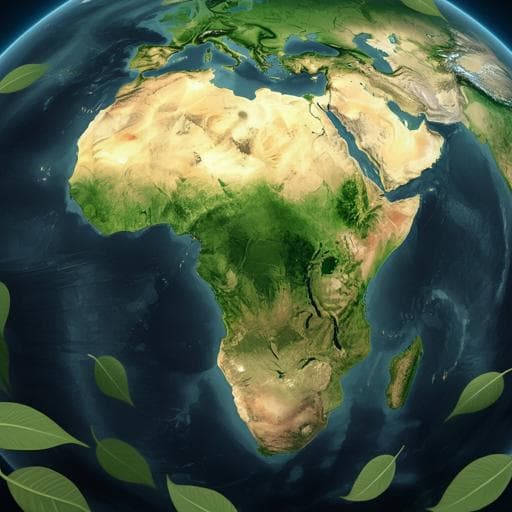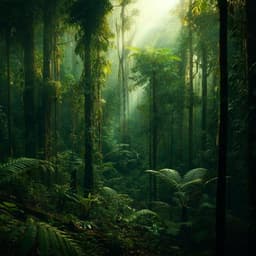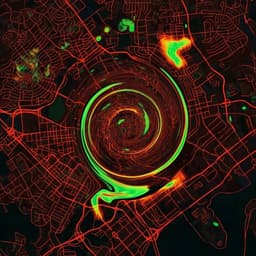
Environmental Studies and Forestry
More than one quarter of Africa's tree cover is found outside areas previously classified as forest
F. Reiner, M. Brandt, et al.
This groundbreaking research by Florian Reiner and colleagues utilizes PlanetScope nanosatellite imagery to unveil that a staggering 29% of tree cover in Africa exists outside previously defined forest areas. This high-resolution mapping could change the way we assess land use impacts and formulate natural climate solutions.
~3 min • Beginner • English
Introduction
Forests and other tree-based ecosystems remove CO2 emissions and are central to climate change mitigation efforts, including commitments under the Glasgow Pact to halt and reverse deforestation by 2030. Effective action requires high-quality monitoring systems to support measurement, reporting, and verification (MRV) of forest area and change across countries. However, tree losses and gains also occur in non-forest landscapes (e.g., scattered trees in savannas, agroforestry, woodlots), which are often overlooked or ambiguously defined in current systems. FAO classifies lands into forest, other wooded land, and other land, but many African landscapes are drylands where trees outside forests constitute the major woody component. Prior assessments indicate that forests cover 21.4% of Africa, 14.9% is other wooded land, and 63.7% is other land that includes diverse tree complexes outside forests (e.g., agroforestry, urban trees). These non-forest trees are critical for ecological stability, livelihoods, and food security. Existing moderate-resolution satellite products (10–30 m) struggle to characterize individual trees outside forests and often miss low-density tree cover. Sub-metre imagery can map individual trees but is costly, temporally inconsistent, and difficult to scale to continents. There is thus a critical gap for repeated, high-resolution, temporally consistent mapping of both forest and non-forest trees at continental scale to improve MRV, better separate trees from shrubs, incorporate canopy height information, and harmonize definitions across countries and years.
Literature Review
Previous global and continental mapping efforts largely rely on 10–30 m satellite data (e.g., Landsat, Sentinel-2) to map forest cover and change, including fractional cover approaches, but these miss or poorly capture scattered trees and low-density woody cover typical of drylands. Very high resolution (sub-metre) studies using commercial satellites and advanced machine learning have demonstrated individual-tree mapping across large areas, yet their use mixes imagery from different years/seasons, obscures change, and is prohibitively expensive and technically demanding for continental-to-global, repeated assessments. Moderate-resolution products can show artefacts in tree cover distributions (e.g., a gap at 60–80% cover in MODIS-based products) that have been interpreted as alternative stable states but may instead reflect methodological biases. FAO statistics provide standardized categories (forest, other wooded land) but include shrubs and shorter woody vegetation that differ from tree-focused remote sensing maps. These gaps and inconsistencies motivate the present work to deliver annual, very high-resolution, temporally consistent tree cover mapping that captures both forest and non-forest trees and enables comparison with FAO categories and state-of-the-art products.
Methodology
- Study design and imagery: Used 3 m PlanetScope 4-band (Blue, Green, Red, NIR) surface reflectance scenes for all of Africa in 2019 (~230,000 scenes; total area ~24.22 million km²). Built custom mosaics on a 1°×1° grid selecting a narrow, phenology-informed time window per tile to maximize tree foliage while minimizing grass interference (deciduous tiles: senescence to mid-greendown; non-deciduous: mid-greendown to dormancy), guided by MODIS MCD12Q2 phenology and Copernicus Dynamic Land Cover. In cloud-prone regions, extended the window to achieve ≥99% coverage. Scenes were clipped, reprojected to WGS84, merged, and histogram-matched to Landsat reference imagery from the same period to normalize reflectance.
- Deep learning segmentation: Employed a UNet-based CNN with batch normalization and self-attention, trained on >130,000 manually delineated samples (individual trees and merged canopy clusters) from 21 countries and diverse ecosystems. Labels captured clearly identifiable woody plants with associated shadows, typically excluding shrubs/bushes below ~5 m height. Data augmentation included flips, crops, affine transforms, and contrast adjustments. Used an adapted focal Tversky loss to handle class imbalance.
- Upsampling and model ensemble: Implemented dynamic in-memory upsampling from 3 m to 1 m during training and inference for non-forest trees to preserve fine label detail and leverage contextual cues (e.g., shadows), improving detection of small crowns. Trained two specialized models: a 1 m non-forest model and a 3 m forest model (larger context favored for forests). Final predictions were ensembled.
- Map production and aggregation: Produced a binary tree/no-tree map at 1 m, then aggregated to 30×30 m grid cells to compute percent tree cover. Defined non-forest thresholds at <10% and 10–25% canopy cover; cells >25% were considered forest. Forest was further stratified by canopy height using external canopy height maps (GEDI/Landsat-integrated products at 10–30 m resolution). Flexibility is retained to apply alternative thresholds or canopy height datasets.
- Ancillary data and analyses: Used ESA WorldCover 2020 (10 m) for land cover, masking water and identifying croplands; CHIRPS (1982–2018) to relate tree cover to rainfall; compared with Hansen et al. global tree cover (2000 baseline updated to 2019 via gains/losses). Quantified trees on croplands by counting segmented objects, with objects >200 m² treated as clusters and divided by 200 m² to estimate tree counts.
- Validation with LiDAR/UAV CHMs: Compared percent tree cover against canopy height models from airborne LiDAR/UAV stereo photogrammetry in Senegal (4.6 km²; 3–70 cm), Mozambique (68.5 km²; 1 m), and DRC (79.6 km²; 1 m). Computed plot-level correlations and RMSE across 59 plots (Senegal, 2–15 ha) and 400 random 50 ha plots each for Mozambique and DRC under varying CHM height thresholds (3–7 m). Best agreement at 5–6 m, consistent with mapping trees ≥~5–6 m. Bias computed as relative plot-level and overall bias.
- Single-tree detection assessment: Compared isolated tree detections on croplands with 50 cm WorldView-based individual tree maps from prior work (aligned post-2015 scenes, similar month). PlanetScope detections become reliable for crowns ≥30 m²; ~44.2% omission for crowns <30 m². The PlanetScope model does not split closed canopies into individuals.
- Country-scale comparisons: Aggregated national tree cover and compared with FAO FRA statistics using FAO definitions for forest and other wooded land to assess alignment and definitional differences.
Key Findings
- Continental tree cover outside mapped forest: 29% of all tree cover occurs outside areas previously classified as tree cover in state-of-the-art maps based on Sentinel-2 10 m imagery; 28.7% of tree cover is outside the ‘tree cover’ class in ESA WorldCover.
- Non-forest tree fractions: 15.8% of tree cover is in areas with <25% canopy cover; 6.0% in areas with <10% canopy cover.
- Rainfall distribution of tree cover: 0.16% (hyper-arid, 0–150 mm), 0.7% (arid, 150–300 mm), 4.3% (semi-arid, 300–600 mm), 27.5% (sub-humid, 600–1200 mm), 67.0% (humid, >1200 mm) of total tree cover.
- Country-level TOF dominance: Trees outside forests (>25% threshold for forest) constitute >50% of national tree cover in nine countries: Botswana, Burkina Faso, Eritrea, Libya, Mali, Namibia, Niger, Mauritania, Sudan.
- Cropland trees: Only 1.7% of total tree cover is in croplands, yet an estimated ~433 million trees occur on African croplands with mean density 2.55 ± 5.81 trees/ha. Western Africa shows the highest mean cropland tree density across much of the rainfall gradient. Thresholds where cropland tree density rises: ~250 mm (West), ~500 mm (East), ~700 mm (Central/Southern Africa).
- Comparison with FAO FRA 2019: Mapped forest area 7,519,197 km² vs FAO 6,374,249 km²; mapped ‘other wooded land’ 1,830,553 km² vs FAO 4,438,199 km² (differences reflect inclusion/exclusion of shrubs and differing definitions/plantation treatment).
- Validation metrics (LiDAR/UAV CHMs, using ~5–6 m height threshold): Senegal R²≈0.81, RMSE≈16.2%; Mozambique R²≈0.62, RMSE≈5.2%; DRC R²≈0.93, RMSE≈10.0%. Overall RMSE 9.19% (6 m threshold) and 9.57% (5 m threshold). Bias at 5 m threshold: plot bias +1.29% (overestimation), total bias –6.90% (underestimation).
- Ecosystem state artefact: Random-sample analysis shows no gap at 60–80% tree cover along rainfall gradients, supporting the view that gaps seen in MODIS-based maps are artefacts of processing rather than alternative stable states.
Discussion
The study demonstrates that annual, very high-resolution mapping of both forest and non-forest trees at continental scale is feasible using PlanetScope imagery and deep learning, enabling precise MRV across countries and ecosystems. By capturing scattered trees and low-density woody cover often missed by moderate-resolution products, the map refines national and continental assessments of woody resources, carbon stocks, and land-use impacts. The finding that ~29% of tree cover lies outside previously mapped tree cover underscores the importance of including non-forest trees in monitoring frameworks and policy, particularly in African drylands where they provide vital ecosystem services. The lack of a 60–80% tree cover ‘gap’ supports reinterpretations of savanna–forest dynamics and challenges prior evidence for alternative stable states derived from coarser products. Comparisons with FAO categories highlight definitional mismatches—this product generally maps more ‘forest’ and less ‘other wooded land’ due to exclusion of shrubs and differing plantation treatments—suggesting the potential to harmonize and even move beyond rigid forest definitions by reporting tree cover at flexible thresholds and incorporating canopy height. The methodology and tools pave the way for global, annual monitoring of tree cover, with the potential to detect fine-scale changes including degradation, encroachment, small-scale deforestation, and agroforestry dynamics, thereby supporting multiple international conventions and restoration initiatives.
Conclusion
This work delivers a prototype, continent-wide, very high-resolution map of African tree cover for a single year, capturing both forest and non-forest trees down to near-individual crown scale. It reveals that more than a quarter of Africa’s tree cover lies outside areas previously mapped as tree cover, reshaping understanding of woody resources, especially in drylands. The approach provides a robust foundation for MRV, natural climate solutions, restoration monitoring, and harmonization across diverse forest definitions. Future research should: expand globally leveraging NICFI data; integrate higher-resolution canopy height information (e.g., LiDAR) to refine tree/shrub separation and forest stratification; improve detection and delineation of small trees and individual crowns within closed canopies; and link with longer-term archives (e.g., Landsat) for change analysis. As mapping precision and repeatability improve, tree cover can serve as a transparent, policy-relevant metric across the full AFOLU landscape.
Limitations
- Detection threshold: Reduced sensitivity to small, isolated trees; reliable detection typically for crowns ≥30 m², with ~44% omission below 30 m², limiting monitoring of new plantings, natural regeneration, and bushes.
- Individual delineation: Closed canopies and dense thickets are not split into individual trees, constraining crown-based allometry and per-tree analyses in forests.
- Canopy height constraints: Forest stratification relies on relatively coarse-resolution canopy height maps (GEDI-based); effective minimum mapped height is ~5–6 m, but not a strict threshold—some shrubs may be included and some trees >5 m may be missed.
- Canopy gap detection: 3 m inputs cannot resolve small gaps within dense crowns, potentially overestimating cover in some forests/shrublands, especially with understory.
- Temporal coverage: PlanetScope imagery is unavailable prior to ~2015, complicating long-term change analyses without cross-sensor calibration (e.g., with Landsat).
- Precision vs cost trade-off: PlanetScope offers lower precision than sub-metre sensors but greater scalability, availability, and repeatability; ongoing improvements may mitigate current limitations.
Related Publications
Explore these studies to deepen your understanding of the subject.







